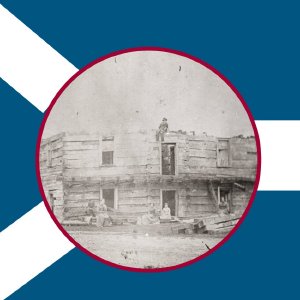With February our theme shifts to "Contention for the Confluence," the time in the late eighteenth and early nineteenth centuries when relationships between the native Indians and settlers heading west became increasingly tense.
Located at the western edge of the Great Black Swamp, the confluence of the three rivers and its precious portage was a crossroads between the Great Lakes and Mississippi Valley. In times of conflict, Kekionga became increasingly significant in the struggle between United States westward expansion and the resulting Indian resistance.
In response to several failed military expeditions, President George Washington sent General Anthony Wayne to occupy Kekionga. Wayne's troops soundly defeated the Miami Confederacy at the Battle of Fallen Timbers in 1794 and construction soon began on the first of three American forts at the headwaters of the Maumee River. Peace was fleeting, as the area witnessed several military engagements two decades later during the War of 1812. Shortly before Indiana achieved statehood, military conflicts abated, giving way to an uneasy cultural conflict between native peoples and Americans drawn to the area for settlement.
Be sure to visit our virtual exhibit page again in March to view the next installment of 200@200.
What is 200@200?
As Indiana embarked on its bicentennial anniversary and reflected on past challenges, successes, and opportunities, we too reflected on 200 years of our part of Indiana. How had Fort Wayne changed? What had we discovered? What would we take with us into the next century?
The 200@200 project was a celebration of Fort Wayne's legacy of progress throughout Indiana's 200 years of history. Using artifacts from the museum's collection of 28,000 objects, the History Center told 200 unique stories of Fort Wayne's role in the 200 years of Indiana's statehood throughout the 2016 bicentennial year. Each month highlighted a different historical theme and presented a collective mosaic of the community's shared past and present, commemorating the progress, growth, and creativity of the "Summit City." Each month's theme was featured in a virtual exhibit and in person at the History Center.
The History Center was honored to share that 200@200 had been endorsed by the Indiana Bicentennial Commission as an official Legacy Project. WANE served as the project's media sponsor.

